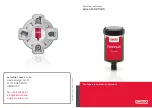
Residential Pendent and
Recessed Pendent Sprinklers
Mizar™ S210, K=3.0
GENERAL DESCRIPTION
The Star Mizar S210 Residential Pendent and Recessed
Pendent Sprinklers are decorative glass bulb sprinklers
designed for use in residential occupancies such as
homes, apartments, dormitories, and hotels.
They are to be used in wet pipe residential sprinkler sys-
tems for one- and two-family dwellings and mobile homes
per NFPA 13D; wet pipe residential sprinkler systems for
residential occupancies up to and including four stories in
height per NFPA 13R; or, wet pipe sprinkler systems for
the residential portions of any occupancy per NFPA 13.
The Mizar S210 has a 3.0 (43,2) K-factor which provides
very low design flow rates at reduced residual pressures,
enabling smaller pipe sizes and water supply require-
ments.
The 155°F/68°C recessed version of the Mizar S210 us-
ing a #2085 Recessed Escutcheon provides 1/2 inch
(12,7 mm) of recessed adjustment or up to 3/4 inch
(19,1 mm) of total adjustment from the flush pendent posi-
tion. The 175°F/79°C recessed version of the Mizar S210
using a #2084 Recessed Escutcheon provides 1/4 inch
(6,4 mm) of recessed adjustment or up to 1/2 inch
(12,7 mm) of total adjustment from the flush pendent posi-
tion. The recessed adjustment substantially reduces the
accuracy to which the length of fixed pipe drops to the
sprinklers must be cut.
The Mizar S210 has been designed with heat sensitivity
and water distribution characteristics proven to help in
the control of residential fires to improve the chance for
occupants to escape or be evacuated. However, residen-
tial fire sprinkler systems are not a substitute for intelli-
gent fire safety awareness or fire safety construction re-
quired by building codes.
WARNINGS
The Mizar S210 Residential Pendent and Recessed
Pendent Sprinklers described herein must be in-
stalled and maintained in compliance with this docu-
ment, as well as with the applicable standards of the
National Fire Protection Association, in addition to
the standards of any other authorities having jurisdic-
tion. Failure to do so may impair the integrity of these
devices.
Because of the above cited stipulations and the var-
ied nature of residential type architecture, there will
be some compartment designs which cannot be fully
sprinklered in accordance with the recommendations
of NFPA 13, 13D, or 13R. In the event of this condi-
tion, consult the authorities having jurisdiction for
guidance and approval.
It is the responsibility of the installing contractor to
provide a copy of this document to the owner or his
representative, and in turn, it is the obligation of the
owner to provide a copy of this document to a suc-
ceeding owner.
The owner is responsible for maintaining their fire
protection system and devices in proper operating
condition. The installing contractor or sprinkler manu-
facturer should be contacted relative to any ques-
tions.
OPERATION
The glass bulb contains a fluid which expands when ex-
posed to heat. When the rated temperature is reached,
the fluid expands sufficiently to shatter the glass bulb,
which then allows the sprinkler to activate and flow water.
TECHNICAL DATA
Approvals
UL and ULC Listed. NYC Accepted (MEA 212-98-E).
(The approvals apply only to the service conditions indi-
cated in the Design Criteria section.)
Maximum Working Pressure
175 psi (12,1 bar)
Discharge Coefficient
K = 3.0 GPM/psi
1/2
(43,2 LPM/bar
1/2
)
Temperature Ratings
155°F/68°C or 175°F/79°C
Finishes
Sprinkler: White Polyester, Chrome Plated, Natural Brass
Recessed Escutcheon: White Coated or Chrome Plated
(Colors other than white available on request.)
Physical Characteristics (Ref. Figure 1)
The Mizar S210 utilizes a dezincification resistant (DZR)
bronze frame. The button is phosphor bronze, and the
bushing is brass. The gasketed spring plate consists of a
beryllium nickel disc spring that is sealed on both its in-
side and outside edges with a Teflon
gasket. The ejec-
tion spring is stainless steel, the compression screw is
phosphor bronze, and the deflector is brass.
SIN S2320
155°F/68°C #2320 Shown With
#2085 Recessed Escutcheon
Customer Service/Sales: Tel: (800) 558-5236 • Fax: (414) 570-5010
Technical Services: Tel: (800) 381-9312 • Fax: (800) 791-5500
7-02
1-3.2.30
TYCO FIRE PRODUCTS
SPRI
NKLERS
F
OR
REPLA
CEMENT
USE
ONL
Y
IN
EXIS
T
ING
SPRI
NKLER
SY
STEMS
OBSOLETE


























